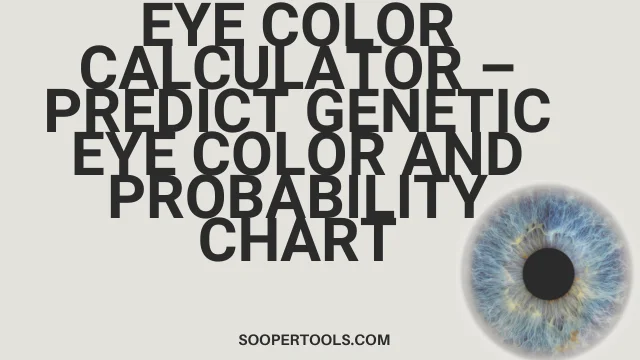Eye Color Calculator – Predict Genetic Eye Color and Probability Chart

Eye Color Calculator – Predicting the Shades of Your Baby’s Eyes
One of the most exciting parts of expecting a baby is imagining what they will look like. Parents often wonder whose smile the child will inherit or whether the baby will have dark, blue, green, or hazel eyes. An eye color calculator makes this curiosity easier to explore by using genetics to estimate possible outcomes. While it cannot provide a guarantee, it offers a probability based on the genetic patterns that shape eye color.
A genetic eye color calculator works by analyzing the combination of eye colors from both parents. Since eye color is influenced by multiple genes, the results are expressed as probabilities rather than certainties. For example, two brown eyed parents may still have a chance of passing on blue or green eyes, depending on their genetic background. This is why many parents turn to an eye color probability chart to see all the possible outcomes visually.
For those who are curious about more specific shades, such as hazel, an eye color calculator with hazel included provides additional insights. Hazel eyes are a blend of green, brown, and sometimes gold tones, and their inheritance can be less predictable. An eye color possibility chart can help families understand how common or rare such variations might be.
In the sections ahead, we will explain how eye color calculators work, explore the role of genetics in determining eye shades, and look at probability charts that highlight the fascinating variety of outcomes. By the end, you will have a clear picture of how science explains one of the most personal traits of your child.
How an Eye Color Calculator Works
An eye color calculator is based on the science of genetics. Eye color is primarily influenced by the interaction of genes that control the production and distribution of melanin, the pigment responsible for the shade of the iris. The more melanin present, the darker the eyes appear. Less melanin often results in blue or green eyes, while a moderate amount can lead to hazel.
A genetic eye color calculator typically uses the eye colors of both parents as input. Behind the scenes, it applies probabilities drawn from genetic inheritance patterns. For example, if one parent has brown eyes and the other has blue eyes, the baby is more likely to inherit brown eyes, but there is still a measurable chance for blue or even green. This probability is often displayed through an eye color probability chart, which shows the percentages of each possible outcome.
Some calculators go further by including hazel as a distinct possibility. An eye color calculator with hazel considers variations in melanin levels that do not fall neatly into brown, blue, or green. Since hazel eyes are a unique blend, their likelihood can be harder to estimate, but modern calculators provide a more accurate probability range.
In simple terms, the calculator works like a probability tool. It does not predict with certainty, but it gives families a clearer idea of the chances, similar to how a family tree might show inherited traits. An eye color possibility chart helps parents visualize the outcomes in percentages, making the science more understandable.
Factors That Influence Eye Color
Eye color is often described as a genetic trait, but several factors combine to create the final shade that appears in a child’s eyes. While a genetic eye color calculator focuses on inherited genes, real world outcomes are shaped by multiple influences.
The primary factor is the amount of melanin in the iris. High levels of melanin usually produce brown eyes, while low levels lead to blue eyes. Moderate levels can result in green or hazel eyes. The way melanin is distributed also affects how light reflects off the iris, creating unique variations in shade.
Another key factor is polygenic inheritance. Unlike traits controlled by a single gene, eye color is influenced by multiple genes working together. This is why an eye color probability chart does not give a single answer but shows percentages. A baby with two blue eyed parents may have a high probability of blue eyes, but there is still a chance of green depending on hidden gene combinations.
Hazel eyes are a good example of complexity. An eye color calculator with hazel shows how intermediate levels of melanin and light scattering create mixed shades of brown, green, and gold. These subtle differences make predicting hazel eyes less straightforward than predicting brown or blue.
Environmental factors can also play a role. Babies are often born with blue or gray eyes because melanin has not fully developed. Over the first year, melanin levels increase, sometimes darkening the eye color permanently. In rare cases, medical conditions or aging can even alter eye color later in life.
An eye color possibility chart reflects these variations by showing a range of outcomes rather than a fixed prediction. Genetics provides the foundation, but biology and environment shape the final result.
Eye Color Possibility Chart by Parent Combinations
While no chart can predict eye color with certainty, probability estimates based on genetics give families a useful guide. The table below represents typical outcomes often used in an eye color calculator.
| Parent 1 | Parent 2 | Brown Eyes Probability | Blue Eyes Probability | Green Eyes Probability | Hazel Eyes Probability |
|---|---|---|---|---|---|
| Brown | Brown | About 75% | About 6% | About 12% | About 7% |
| Brown | Blue | About 50% | About 37% | About 9% | About 4% |
| Brown | Green | About 37% | About 12% | About 38% | About 13% |
| Blue | Blue | About 1% | About 99% | Rare | Very rare |
| Blue | Green | About 12% | About 50% | About 34% | About 4% |
| Green | Green | About 25% | About 25% | About 46% | About 4% |
This chart shows why an eye color probability chart is so helpful. It simplifies complex genetics into a visual guide that parents can easily interpret.
For example, two blue eyed parents almost always pass on blue eyes, while a mix of brown and green eyes gives the widest spread of possibilities. Hazel eyes often appear as an intermediate result, which is why an eye color calculator with hazel provides extra clarity for families curious about this shade.
How to Use an Eye Color Calculator Step by Step
Using an eye color calculator is easy and can be done in just a few steps. While the results are based on probabilities, the process gives families an engaging way to explore genetics.
- Enter the parents’ eye colors
Most calculators begin by asking for the eye color of each parent. Common options include brown, blue, green, and sometimes hazel. - Consider grandparents’ eye colors if available
Some advanced genetic eye color calculators allow you to add grandparents’ eye colors for a more refined probability. This helps account for hidden genes that may influence the outcome. - View the probability chart
Once the data is entered, the calculator generates percentages that show the chance of your child inheriting each eye color. An eye color probability chart is often displayed to make the results easier to understand. - Look for special outcomes like hazel
If you are curious about hazel eyes, use an eye color calculator with hazel included. This feature helps estimate the chance of this unique shade appearing, even if it is less common. - Interpret results as possibilities, not guarantees
Remember that the results are estimates. Eye color is influenced by multiple genes, so while the calculator provides a probability, the actual outcome may still surprise you. An eye color possibility chart is meant to guide expectations rather than give certainty.
This step by step process makes the calculator a fun and educational tool for families. It not only sparks curiosity but also introduces the fascinating science of genetics in a way that is easy to understand.




